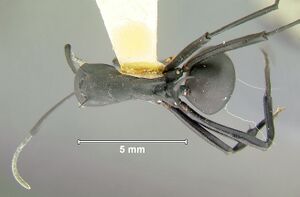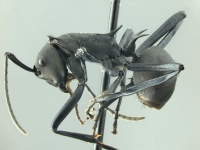Polyrhachis hector
| Polyrhachis hector | |
|---|---|

| |
| Scientific classification | |
| Kingdom: | Animalia |
| Phylum: | Arthropoda |
| Class: | Insecta |
| Order: | Hymenoptera |
| Family: | Formicidae |
| Subfamily: | Formicinae |
| Tribe: | Camponotini |
| Genus: | Polyrhachis |
| Subgenus: | Myrmhopla |
| Species: | P. hector |
| Binomial name | |
| Polyrhachis hector Smith, F., 1857 | |
| Synonyms | |
| |
Identification
A member of the Polyrhachis hector species group.
Kohout (2008) - Specimens of Polyrhachis hector feature a set of distinct, spur-like spines along the inner edge of the hind tibia, that are lacking in Polyrhachis abdominalis. The latter species is also distinctly more slender.
Distribution
Latitudinal Distribution Pattern
Latitudinal Range: 7.42062° to -6.566666667°.
| North Temperate |
North Subtropical |
Tropical | South Subtropical |
South Temperate |
- Source: AntMaps
Distribution based on Regional Taxon Lists
Indo-Australian Region: Borneo, Indonesia, Malaysia, Philippines, Singapore (type locality).
Oriental Region: India, Myanmar.
Distribution based on AntMaps
Distribution based on AntWeb specimens
Check data from AntWeb
Countries Occupied
| Number of countries occupied by this species based on AntWiki Regional Taxon Lists. In general, fewer countries occupied indicates a narrower range, while more countries indicates a more widespread species. |

|
Estimated Abundance
| Relative abundance based on number of AntMaps records per species (this species within the purple bar). Fewer records (to the left) indicates a less abundant/encountered species while more records (to the right) indicates more abundant/encountered species. |

|
Biology
Castes
   
| |
| . | Owned by Museum of Comparative Zoology. |
Nomenclature
The following information is derived from Barry Bolton's Online Catalogue of the Ants of the World.
- rubiginosa. Formica ruiginosa Le Guillou, 1842: 316 (w.) BORNEO. [Junior primary homonym of Formica rubiginosa Latreille, 1802c: 170.] Wheeler, G.C. & Wheeler, J. 1990b: 760 (l.). Combination in Polyrhachis: Roger, 1863b: 7 (spelling emended to rubiginosa); in P. (Myrmhopla): Wheeler, W.M. 1919e: 130. Senior synonym of hector Smith, F. 1857a: 62, hence the latter the first available replacement name for rubiginosa Le Guillou: Dorow, 1995: 55.
- hector. Polyrhachis hector Smith, F. 1857a: 62 (w.) SINGAPORE. Imai, Brown, et al. 1984: 68 (k.). Combination in P. (Myrmhopla): Emery, 1925b: 193. [Earliest junior synonym of rubiginosa Le Guillou, 1842: 316 (junior primary homonym of rubiginosa Latreille, 1802c: 170) and hence first available replacement name: Dorow, 1995: 55.] Senior synonym of malignus, reversa: Bolton, 1974b: 174; of achilles: Dorow, 1995: 55.
- malignus. Polyrhachis malignus Smith, F. 1858b: 70, pl. 4, fig. 44 (q.) PHILIPPINES. Combination in P. (Myrmhopla): Emery, 1925b: 195. Junior synonym of hector: Bolton, 1974b: 174.
- achilles. Polyrhachis achilles Forel, 1893c: 24 (diagnosis in key) (w.) MYANMAR. Junior synonym of abdominalis: Bingham, 1903: 398; of hector: Dorow, 1995: 55.
- reversa. Polyrhachis abdominalis var. reversa André, 1896b: 253 (w.) PHILIPPINES. Combination in P. (Myrmhopla): Emery, 1925b: 192. Junior synonym of hector: Bolton, 1974b: 174.
The following notes on F. Smith type specimens have been provided by Barry Bolton (details):
Polyrhachis hector
Holotype worker in Oxford University Museum of Natural History. Labelled “SING. 9” (= Singapore) and with a Donisthorpe type-label.
Description
Karyotype
- n = 21, 2n = 42 (Malaysia) (Imai et al., 1983).
References
- André, E. 1896d. Fourmis nouvelles d'Asie et d'Australie. Rev. Entomol. (Caen) 15: 251-265.
- Bolton, B. 1974b [1973]. New synonymy and a new name in the ant genus Polyrhachis F. Smith (Hym., Formicidae). Entomol. Mon. Mag. 109: 172-180 (page 174, Senior synonym of malignus and reversa)
- Cantone S. 2017. Winged Ants, The Male, Dichotomous key to genera of winged male ants in the World, Behavioral ecology of mating flight (self-published).
- Dorow, W. H. O. 1995. Revision of the ant genus Polyrhachis Smith, 1857 (Hymenoptera: Formicidae: Formicinae) on subgenus level with keys, checklist of species and bibliography. Cour. Forschungsinst. Senckenb. 185: 1-113 (page 55, Senior synonym of achilles)
- Emery, C. 1925d. Hymenoptera. Fam. Formicidae. Subfam. Formicinae. Genera Insectorum 183: 1-302 (page 193, Combination in P. (Myrmhopla))
- Imai, H. T.; Brown, W. L., Jr.; Kubota, M.; Yong, H.-S.; Tho, Y. P. 1984. Chromosome observations on tropical ants from western Malaysia. II. Annu. Rep. Natl. Inst. Genet. Jpn. 34: 66-69 (page 68, karyotype described)
- Khachonpisitsak, S., Yamane, S., Sriwichai, P., Jaitrong, W. 2020. An updated checklist of the ants of Thailand (Hymenoptera, Formicidae). ZooKeys 998, 1–182 (doi:10.3897/zookeys.998.54902).
- Kohout, R.J. 2008a. A review of the Polyrhachis ants of Sulawesi with keys and descriptions of new species (Hymenoptera: Formicidae: Formicinae). Memoirs of the Queensland Museum. 52:255-317.
- Roger, J. 1863b. Verzeichniss der Formiciden-Gattungen und Arten. Berl. Entomol. Z. 7(B Beilage: 1-65 (page 8, Replacement name: andromache)
- Smith, F. 1857a. Catalogue of the hymenopterous insects collected at Sarawak, Borneo; Mount Ophir, Malacca; and at Singapore, by A. R. Wallace. [part]. J. Proc. Linn. Soc. Lond. Zool. 2: 42-88 (page 62, worker described)
- Smith, F. 1859a. Catalogue of hymenopterous insects collected by Mr. A. R. Wallace at the islands of Aru and Key. [part]. J. Proc. Linn. Soc. Lond. Zool. 3: 132-158 (page 142, worker described)
- Yamane, S., Tanaka, H.O., Hasimoto, Y., Ohashi, M., Meleng, P., Itioka, T. 2021. A list of ants from Lambir Hills National Park and its vicinity, with their biological information: Part II. Subfamilies Leptanillinae, Proceratiinae, Amblyoponinae, Ponerinae, Dorylinae, Dolichoderinae, Ectatomminae and Formicinae. Contributions from the Biological Laboratory, Kyoto University 31, 87–157.
References based on Global Ant Biodiversity Informatics
- André E. 1896. Fourmis nouvelles d'Asie et d'Australie. Rev. Entomol. (Caen) 15: 251-265.
- Ashmead W. H. 1904. A list of the Hymenoptera of the Philippine Islands, with descriptions of new species. J. N. Y. Entomol. Soc. 12:1-22.
- Bolton B. 1974. New synonymy and a new name in the ant genus Polyrhachis F. Smith (Hym., Formicidae). Entomol. Mon. Mag. 109: 172-180
- Emery C. 1886. Saggio di un catalogo sistematico dei generi Camponotus, Polyrhachis e affini. Memorie della Reale Accademia delle Scienze dell'Istituto di Bologna 5: 363-382
- Fayle T. M., E. C. Turner, J. L. Snaddon, V. Khen Chey, A. Y. C. Chung, P. Eggleton, and W. A. Foster. 2010. Oil palm expansion into rain forest greatly reduces ant biodiversity in canopy, epiphytes and leaf-litter. Basic and Applied Ecology 11: 337345.
- Figueras G. S., and O. M. Nuneza. 2013. Species diversity of ants in karst limestone habitats in Bukidnon and Davao Oriental, Mindanao, Philippines. Advances in Environmental Sciences - International Journal of the Bioflux Society 5(3): 306-315.
- Floren A., W. Wetzel, and M. Staab. 2013. The contribution of canopy species to overall ant diversity (Hymenoptera: Formicidae) in temperate and tropical ecosystems. Myrmecological News 19: 65-74.
- Hashimoto Y., Y. Morimoto, E. S. Widodo, and M. Mohamed. 2006. Vertical distribution pattern of ants in a Bornean tropical rainforest (Hymenoptera: Formicidae). Sociobiology 47(3): 697- 710.
- Kohout R.J., and M. Mohamed. 2008. A preliminary list of the Polyrhachis ants of the Maliau Basin Conservation area in Sabah, Borneo (Hymenoptera: Formicidae: Formicinae). Asian Myrmecology 2: 63-70.
- Mathew R. 2003. On Formicidae (Insecta: Hymenoptera) of Nongkhyllem Wild Life Sanctuary, Ri-Bhoi District, Meghalaya. Records of the Zoological Survey of India 101:195-207.
- Mohanraj P., M. Ali, and K. Veerakumari. 2010. Formicidae of the Andaman and Nicobar Islands (Indian Ocean: Bay of Bengal). Journal of Insect Science 10: Article 172
- Mohanraj, P., M. Ali and K. Veenakumari. 2010. Formicidae of the Andaman and Nicobar Islands (Indian Ocean: Bay Of Bengal). Journal of Insect Science 10:172.
- Pfeiffer M.; Mezger, D.; Hosoishi, S.; Bakhtiar, E. Y.; Kohout, R. J. 2011. The Formicidae of Borneo (Insecta: Hymenoptera): a preliminary species list. Asian Myrmecology 4:9-58
- Robson Simon Database Polyrhachis -05 Sept 2014
- Sukimin S., M. Mohamed, and H. Aris. 2010. Ant diversity of Maliau Basin Conservation Area, Sabah, Malaysia. Journal of Tropical Biology and Conservation 6:89-101.
- Tanaka H. O., S. Yamane, and T. Itioka. 2012. Effects of a fern-dwelling ant species, Crematogaster difformis, on the ant assemblages of emergent trees in a Bornean tropical rainforest. Ann. Entomol. Soc. Am. 105(4): 592-598.
- Viehmeyer H. 1912. Ameisen aus Deutsch Neuguinea gesammelt von Dr. O. Schlaginhaufen. Nebst einem Verzeichnisse der papuanischen Arten. Abhandlungen und Berichte des Königlichen Zoologischen und Anthropologische-Ethnographischen Museums zu Dresden 14: 1-26.
- Way M. J., and B. Bolton. 1997. Competition between ants for coconut palm nesting sites. Journal of Natural History 31: 439-455.
- Wheeler W. M. 1909. Ants of Formosa and the Philippines. Bulletin of the American Museum of Natural History 26: 333-345.
- Wheeler W. M. 1919. The ants of Borneo. Bulletin of the Museum of Comparative Zoology 63:43-147.
- Widodo E. S., T. Naito, M. Mohamed, and Y. Hashimoto. 2004. Effects of selective logging on the arboreal ants of a Bornean rainforest. Entomological Science 7: 341-349.
- Widodo E.S., M. Mohamed, and Y. Hashimoto. 2001. Canopy ant diversity assessment in the fragmented rainforest of Sabah, East Malaysia. Nature and Human activities 6: 13-23.
- Yamane S.; Nona, A. R. 1994. Ants from Lambir Hills National Park, Sarawak. Pp. 222-226 in: Inoue, T.; Hamid, A. A. (eds.) 1994. Plant reproductive systems and animal seasonal dynamics. Long-term study of dipterocarp forests in Sarawak. Kyoto: Center for Ecological Research, Kyoto University, vii + 255 pp.

